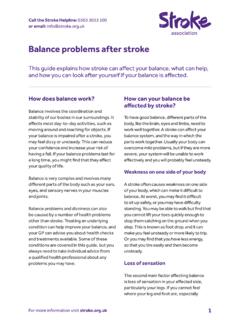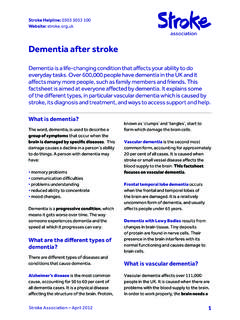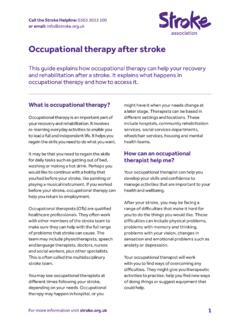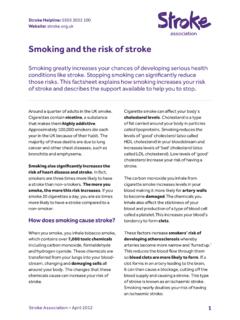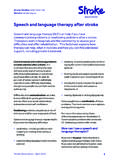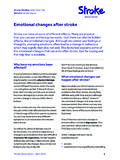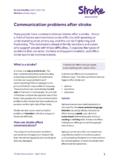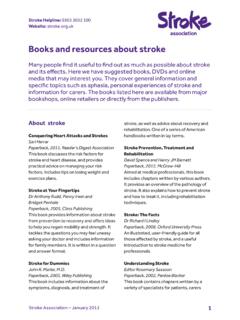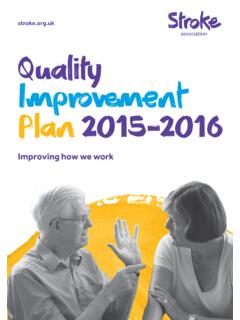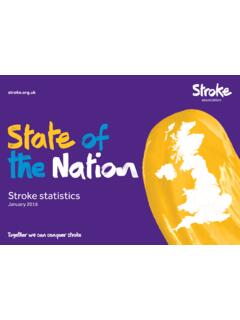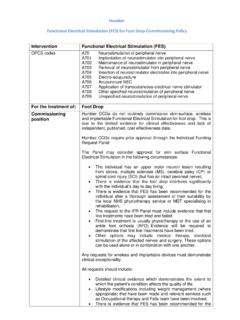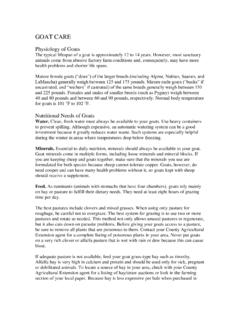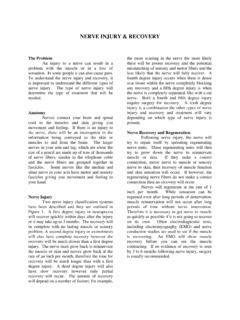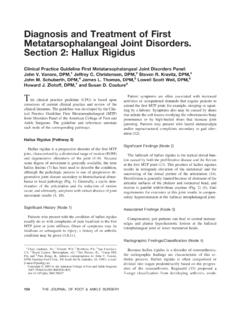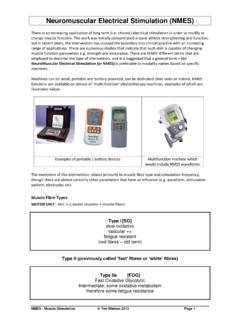Transcription of Physical eects of stroke
1 stroke Helpline: 0303 3033 100 Website: effects of stroke1 stroke Association June 2013 Some of the most common effects of stroke are Physical . You may experience muscle weakness, paralysis, stiffness, or changes in sensation, usually on one side of your body. These effects can make it harder to move some parts of your body, and you may struggle with everyday activities. This factsheet describes these problems and the different treatment options that are are the Physical effects of stroke ?Muscle weaknessWeakness on one side of the body is the most common and well known effect of stroke . If your muscles are weak, you are likely to have some difficulty moving your limbs and moving around in 80% of stroke survivors experience movement problems, but these can vary.
2 You might have a mild weakness in one limb, or part of a limb, and this might limit how well you can move your fingers for example. Some people may have much more severe weakness, and may be unable to move their limbs at all this is called paralysis. Weakness on one side of the body is often referred to as hemiparesis. Paralysis on one side of the body can be called hemiplegia. If you have weakness or paralysis, you may need help with everyday activities. If you have weakness in your leg, you may be more likely to slip, trip or fall. For example, your ankle might turn over when you put weight on it. You will be more likely to have a fall or other problems with your balance if you also have problems with your vision or hearing. For more information see our factsheet F22, Balance problems after footThis is a condition where your toes catch on the ground when you step forward because the muscles that lift your toes (called the dorsiflexors) are weak.
3 StaminaSome people find it difficult to keep moving or active for a long time. For instance, you may find that objects slip from your grasp, or you may struggle to use your cutlery towards the end of a meal. You might also find that despite walking safely at the start of a shopping trip, you become tired and more likely to trip towards the end. Many stroke survivors find that they lose cardiovascular fitness, even if they have little muscle weakness, because they become less active after a stroke . Exercise and stamina training can help you to improve 2 Physical effects of strokeStroke Association June 2013your strength, cardiovascular fitness and endurance. PainPain is another common Physical problem. You may feel pain if your stroke has damaged your brain s pain centre , or it can be caused indirectly as a result of Physical weakness for example.
4 For further information on pain, please see our factsheet F30, Pain after your stroke , you may experience changes in muscle tone. Muscle tone is the amount of resistance or tension in your muscles and enables you to hold your body in a particular position. If your muscle tone has changed you may develop very tight, stiff muscles (known as spasticity), or very weak, floppy muscles (known as flaccidity). As with muscle weakness, changes in muscle tone happen when the area of your brain that controls your muscles is damaged. Spasticity affects up to a third of stroke survivors. It always occurs on the weaker side of your body and may make it difficult to move your limbs. ContracturesSometimes stiffness can cause a permanent shortening of the muscles this is called a contracture.
5 This can sometimes happen if you cannot move your limbs fully and regularly, which affects many people after a stroke . When you aren t moving your limbs regularly, the muscles and soft tissue around your joints can change shape. This can cause some muscles to change length, becoming shorter or longer. Sometimes, these changes in length can become permanent and the muscle and joints become fixed in position. This can mean that the joint cannot be fully bent or straightened and the muscles cannot be stretched to their full length. If you have a contracture, your arm might feel and appear stuck in a bent position. If a contracture affects your leg, you might find it difficult to walk. Contractures may also cause your muscles to tense and contract abnormally, causing spasms these can be painful, especially at in sensationA stroke can affect your sensation in various ways.
6 Feeling less sensitive this is called hypoesthesia. Your limbs may feel numb and this can cause difficulties. For example, if you are unaware of pressure on your skin, such as tight clothing or shoes, they might rub and damage your skin without you noticing. You may also have difficulty eating if your face is numb as you might bite your cheek or tongue without noticing. Feeling less sensitive to temperature. If you experience this you could be at risk of burning yourself or becoming too cold, so you may need to take extra measures to look after yourself. For example, you might need to carefully test water temperatures with your good hand (for example in the shower or when washing up), or you may need to wear gloves and thick socks in cold weather.
7 3 Physical effects of strokeStroke Association June 2013 Feeling more sensitive. This is called hyperesthesia and can affect a range of your senses such as your taste, hearing or touch. After a stroke , some people find watching television or being in crowded places difficult as they seem too loud. Feeling unaware of your position and movement in your limbs. Your body has a system which makes it aware of its position and movement. Some people have problems with this after a stroke . If this is the case for you, you may have difficulty moving around and you might find that you need to look at your limbs to know where they are. Some people notice that their limbs (or part of them) feel like they do not belong to them, or like they have altered size or shape.
8 Experiencing altered sensations this is sometimes called dysesthesia or paresthesia. Common sensations are pins and needles or tingling in your affected limbs. Sometimes these sensations can be unpleasant, such as burning, pressure or feeling like something is running over your skin. How can the Physical effects of stroke be treated?Everybody recovers differently from stroke and the amount of recovery you will make will depend on many factors, including how much damage was done by the stroke . Most people will make the most significant improvements in the first few months after their stroke . After this time, recovery usually slows down but can continue for a long time. Many people carry on making improvements and become fitter and stronger for a long time after their stroke .
9 The timing and amount of therapy you have can help your recovery. Try to begin therapy as soon as you are able to. It is recommended that you should have 45 minutes of therapy (such as physiotherapy or occupational therapy) every rehabilitation therapy might be delivered on a one-to-one basis, in a group, or by having exercises to practise on your own or with the help of your family or carers. treatment for muscle weaknessIf you have any Physical effects after your stroke you should see a physiotherapist. Exercising and practising the activities that you find difficult are good ways to improve. You can try to strengthen your muscles to make them work more efficiently. You can also learn to move and use your muscles in a different way to make up for weak muscles.
10 Physiotherapy will help to prevent other problems, such as muscle stiffness and spasticity. If you are in hospital, the whole stroke team will be working to keep your muscles supple to avoid stiffness. A physiotherapist will assess your problems and will recommend suitable exercises and activities for you. There are different types of exercise to increase your strength, stamina and flexibility. Some people may benefit from using a treadmill to practise walking. As well as giving you exercises, your physiotherapist will help you to practise specific activities such as standing and walking. Occupational therapists also play an important role in helping you to 4 Physical effects of strokeStroke Association June 2013find ways to carry out everyday activities to help maintain your independence.
